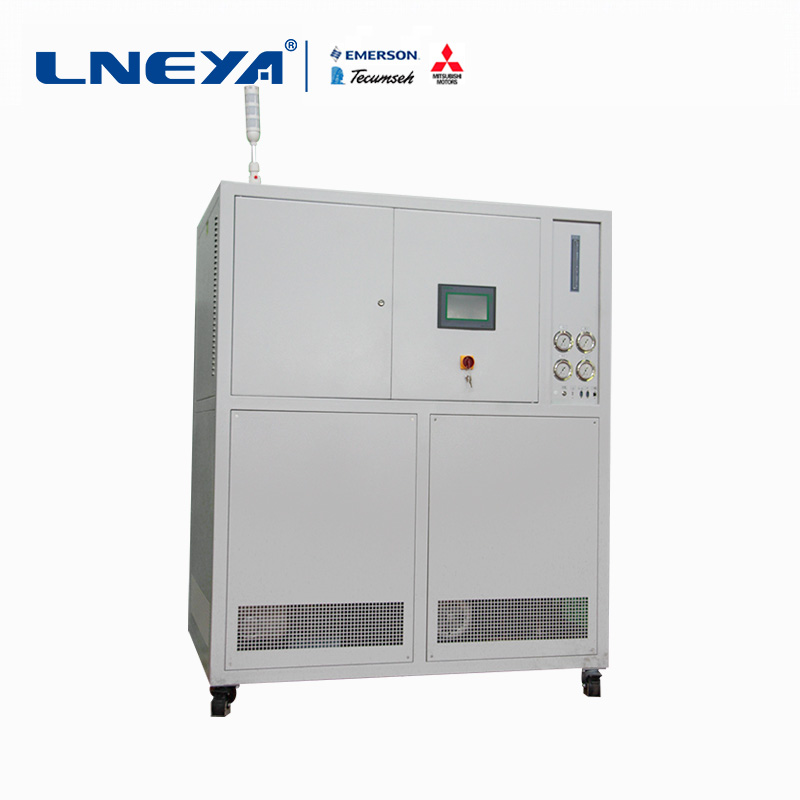Battery-specific temperature cycle test chamber Chiller tips
With the rapid development of the economy, the new energy automobile industry has also achieved rapid development, and the requirements of the battery industry are also getting higher and higher. In order to adapt to related industries, LNEYA has developed and produced the battery-specific temperature cycle test chamber Chiller, which has won the favor of large domestic and foreign companies. Therefore, today Xiaobian made a description of the use of the battery-specific temperature cycle test chamber Chiller.
The pressure ratio of the Chiller cycle of the battery-specific temperature cycle test chamber increases, the gas transmission coefficient of the compressor decreases, the actual suction volume decreases, the cooling capacity decreases, and the compressor power consumption increases, and the refrigeration coefficient decreases. When the actual resistance loss of the system is less than the nameplate head of the circulating water pump, the flow rate of the pump working point is greater than, and the head is less than the pump nameplate parameter. If other conservative factors of the design are added, the intersection of the pump characteristic curve and the system characteristic curve will always be biased to the lower right direction. Therefore, the flow rate will be greater than the larger the pressure ratio, and the greater the influence.
The external temperature of the thermal expansion valve (including the electronic expansion valve) Under normal conditions, the lower half of the expansion valve body is very cool, and there is dew, the refrigerant flow is very dull. Under abnormal conditions, first, the valve body is relatively cold, the surface has more dew, and even frost, the refrigerant has a loud sound (gas flow). The reason is that the filter is blocked, or the refrigerant in the power box leaks, and the valve hole is closed. The temperature of the Chiller capillary of the battery-specific temperature cycle test chamber is normal, the capillary is cool and dew is formed, and there is liquid flow sound. Under abnormal conditions, the surface is very cool and condensation, but the sound of the flow is louder, which is the flow of gas. The reason is that the refrigerant is insufficient. Second, the surface is not cool, condensation does not occur, and the flow sound is not heard. It is a filter blockage or capillary blockage. Battery temperature cycle test chamber Chiller evaporator temperature conditions Under normal conditions, the outer surface of the evaporator is very cold, the condensation water drops continuously, the temperature of the inlet and outlet air is large, usually Δt can be 12~14oC; abnormal situation The surface of the evaporator is not too cool, the dew is not much, or there is no condensation. It can be heard that the flow of the refrigerant is very loud, and the temperature difference between the inlet and outlet is small. The reason is that the refrigerant amount is insufficient, or the expansion valve opening degree is small.
Battery temperature cycle test chamber Chiller fully enclosed reciprocating piston compressor case temperature field can be divided into two parts, the upper case is affected by the suction of steam, the temperature is relatively low, in the slightly hot or slightly cool range, in the suction pipe There is the possibility of dew condensation on the surface of the local casing around it. The heat generated by the motor inside the casing and the frictional heat carried by the frozen oil are mainly carried out by the steam.
The effect of the case temperature is too high and the reason The surface temperature of the case exceeds the normal range, mainly because the intake temperature of the refrigeration system is too high. Excessive heat vapor enters the compressor and absorbs heat from the casing, causing the temperature of the steam to rise, thereby increasing the temperature of the casing. The temperature of the superheated vapor rises very high, and the temperature of the casing rises too high, which is unfavorable for the cooling of the oil, which affects the lubrication of the moving parts, accelerates the wear, and causes the bearing to hug the shaft. It also causes the exhaust gas temperature to rise.
The above are the tips and instructions to be used during the use. You need to contact LNEYA when you need to know the device parameters or even the device video. Email address: sales@lneya.com

 LNEYA Industrial Chillers Manufacturer Supplier -
LNEYA Industrial Chillers Manufacturer Supplier -











